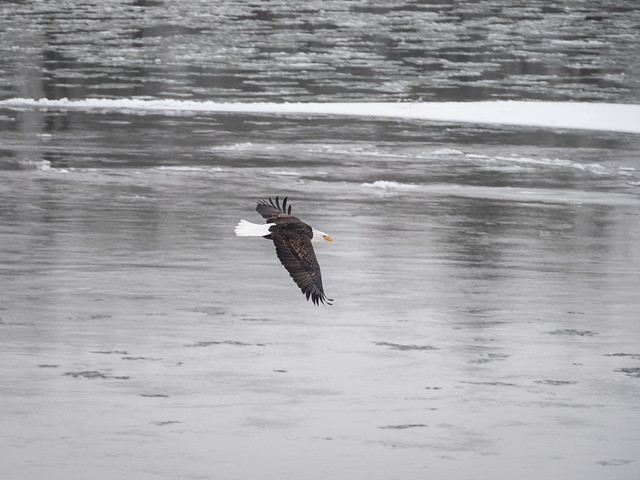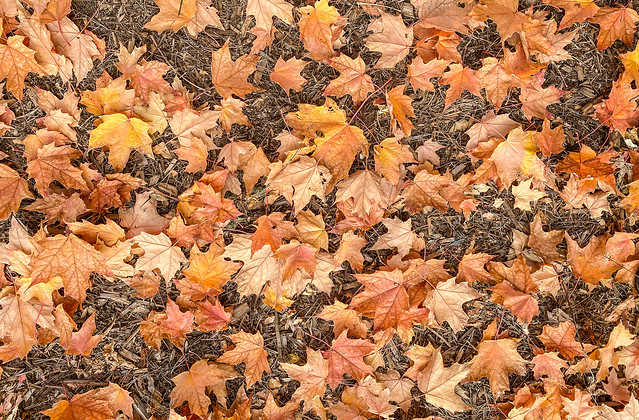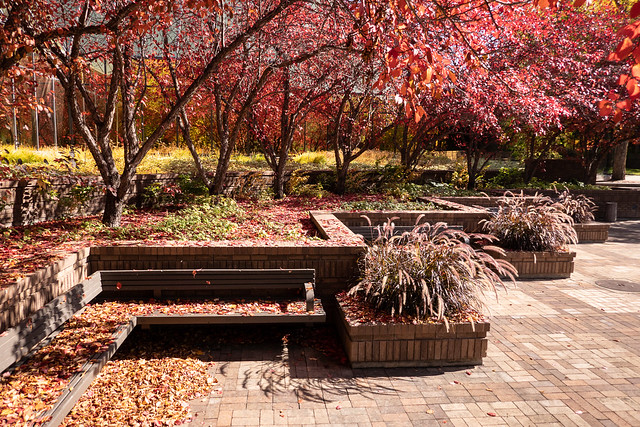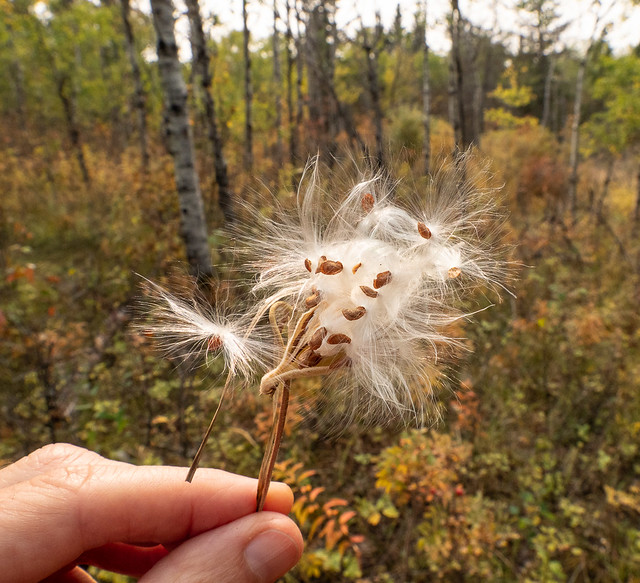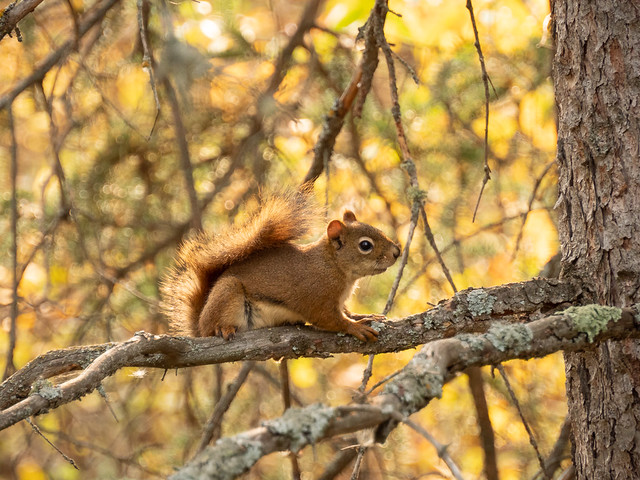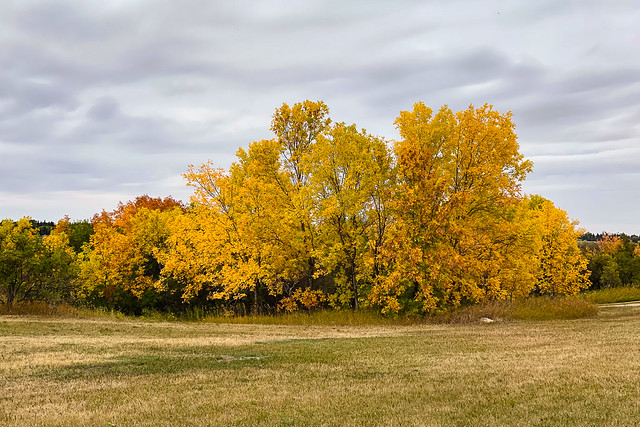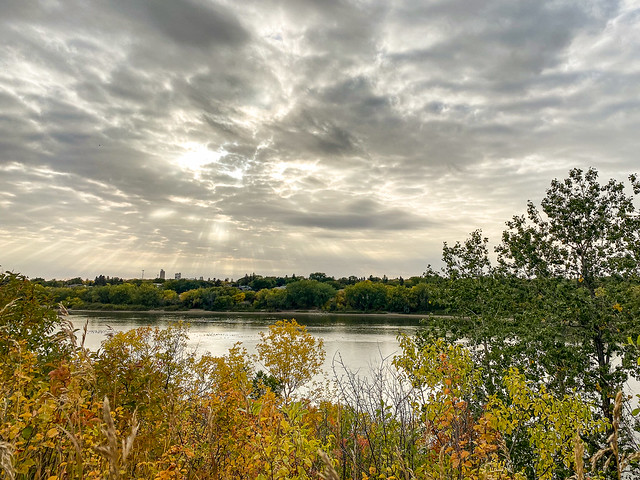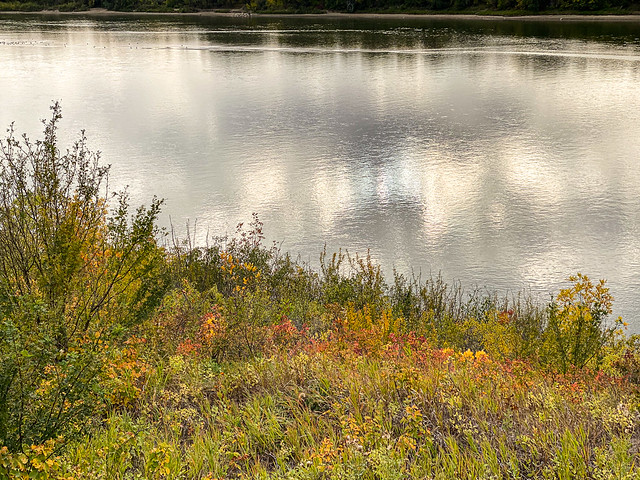Another sunrise from my home office.
Sunday, December 27, 2020
Sunday, December 06, 2020
Wednesday, November 25, 2020
Bald Eagle
I'm back working at home due to Covid, but I needed to pick up some stuff so I walked over to the office. And I decided to take my camera, just in case :-)
I was taking photos of the river and the ice when I saw a bird fly out of the trees nearby. It was large and I instinctively zoomed my telephoto to the max and swung to follow it. As usual, I had the focus set on a center spot which is not the best for tracking birds in flight but there wasn't time to change it. I did my best to take a few shots when I thought I was close to centered. The bird flew across the river and landed in a tree on the other side.
I thought it might be a bald eagle, but I wasn't sure. Maybe it was just a large raven? Zooming in on the shots on my camera I could see the white head and tail of an adult bald eagle. Bald eagles are quite common some places, but I don't see many in Saskatoon. I had seen one about a month ago when I was out running. Maybe they migrate through in the fall? Although the end of November in Saskatoon is more winter than fall.
It was over an hour later when I was walking home on the other side of the river (the railway bridge is one way). I was keeping an eye out for the bald eagle but I didn't really I expect to see it. I figured it would be long gone. I checked out various dead trees along the bank where it might perch. Surprisingly, it was in the same tree I had seen it land in. I'm not sure if it had been sitting there the whole time or whether it just happened to be back there.
It wasn't easy to try to get a good shot. There were lots of branches in the way and the snow was deep off the path. And I didn't want to scare it away so I was moving slowly. Then a magpie landed in the tree near the eagle and started squawking at it. (just visible in the lower left of the photo below) I'm not sure if it was my approach or the magpie or a combination, but the eagle had enough and launched into the air and flew away.
Seeing the bald eagle was a nice surprise for a day I wasn't really expecting much. And despite not having my big lens, I managed to get a few semi-passable photos.
Coincidentally, we recently used a couple of my other bald eagle photos in EcoSask News.
See all 9 photos in this album
Saturday, November 21, 2020
Black & White
My prints from the last few weeks (my usual one per week) have been black and white versions of photos from this last year. So for a little while I have a b&w wall with these three photos (17x22"). Between being b&w and somewhat abstract they won't be most people's cup of tea. I generally prefer color, but it's interesting to see how much of a photo is in the color, and how much in the shapes, forms, and texture.
Sunday, November 15, 2020
Monarchs in Mexico
It’s too easy to forget that verdancy is not the result of careful management,
but of life’s inexorable course, present wherever we don’t suffocate it.
- The Eye of the Sandpiper by Brandon Keim
This is from back in January, on our last pre-Covid trip to Mexico. I took a ton of photographs and video of the monarchs so I left processing them till I got home. Of course, then I never got around to posting them. As Saskatchewan winter sets in, with travel limited, it seems like a good time to think about monarchs flying in the sunshine.
For a long time I've wanted to see the monarch butterflies overwintering in Mexico in huge numbers. Seeing the IMAX film Flight of the Butterflies just made we want to see them in person. We get the occasional monarch in Saskatoon, but not in large quantities like this. Once upon a time abundance in nature was common. Human abundance has put an end to most of that - bison, carrier pigeons, sharks. It made it special to see one of the few remaining concentrations.
We were using Google Maps to navigate in our rental car in Mexico, but Google didn't seem to quite know where the monarch reserves were. We were aiming for El Rosario, but following butterfly signs we ended up at Sierra Chincua Reserve.
As soon as we arrived I was unhappy to see the huge parking lot, the souvenir shops, food booths, and signs for the zip line. I could tell this was not going to be the wonderful experience of nature that I had imagined. And it didn't help that it was the weekend. We walked up the trail with hordes of tourists, the final section shuffling single file. When we finally reached the end I didn't see anything. There were no butterflies flying around. None near the trail. It was a cold cloudy day and the butterflies weren't flying, they were all roosting in the trees, a long way from the trail. There were a lot of monarchs, but not much to see of them. I tried to take some photos but it wasn't what I had hoped for. We were constrained to a narrow path by ropes and guards. Soon the pressure from the line of people drove us away from the butterflies.
We had deliberately allowed two days to visit the butterflies, but we had no desire to go back to the same spot. We decided to continue on to Zitacuaro. If we got up the motivation to try again, there was another sanctuary near there that seemed a bit more off the beaten path. The weather was nice and sunny the next day so we headed for the El Capulin Sanctuary. We pulled into a small parking lot with no other cars. That was positive, but were they even open? It turned out they were. This time we were given a guide. He didn't speak any English, but at least he showed us where to go. They wanted us to ride horses but we said no. It did turn out to be a long hike with quite a bit of uphill, but we were happy to be out hiking in the mountains on a beautiful day. And it's easier to take photographs on foot.
Partway up we started to see the odd monarch. Not knowing if we'd see more, I started photographing them. At least they were out flying around, unlike the day before! As we climbed further, more and more appeared. Soon there was a steady stream of them flowing down the mountain. It's hard to describe the feeling of being surrounded by a seemingly endless stream of butterflies. Up higher the forest was full of them. There were a few bunches roosting, but most of them seemed to be out flying. For me, this was definitely a highlight of nature viewing. I took photos of them in the air, carpeting the ground, covering the bushes, of individuals.
I don't usually take much video but photographs just didn't do this spectacle justice. (best viewed on something bigger than a phone)
Monarchs are amazing creatures. It was actually a Canadian, Fred Urquhart, who discovered the secret of their overwintering in Mexico. Up to 500,000 monarchs migrate from Canada and the US east of the divide to a few overwintering sites in central Mexico - up to 7500 km. (Western monarchs don't fly as far - they overwinter at sites in California and Baja.) It's hard to imagine a fragile butterfly traveling all that way.
How they navigate, and how they know where to go is still an open question. They are thought to have a time-compensated sun compass. In other words they have an internal clock that lets them tell direction by the position of the sun. They may also have a magnetic compass.
While individual butterflies migrate the whole way south, the northward migration takes multiple generations. Butterflies leaving Mexico only make it as far as Texas and Oklahoma, where they find milkweed to lay their eggs on for the next generation. It may take up to four generations to reach Canada.
See also:
all 26 photos in this album
Shelley's monarch blog post
other posts from this trip
Tuesday, November 10, 2020
Sunrise
One of the benefits of this time of year is that I get to watch the sunrise from my home office (without getting up early).
Saturday, October 31, 2020
210
I ran 210 km in October, my highest month this year (and probably for quite a few years). Considering October included snow and rain and below average temperatures, I'm happy with that. Curiously, October was also the peak (of 160 km) for the 12 previous months. Maybe it's because I know winter is fast approaching.
I've averaged roughly 50 km per week for the last three months. That's getting hard to get in only three runs per week. I can do it with say 12 + 12 + 26 but it's easier to fit in an additional one or two easy 5 km runs e.g. 10 + 5 + 10 + 25.
Covid has actually been good for my running. With no travel and fewer other distractions, I've been a lot more consistent than most years. Over the last 12 months (which included some pre-Covid travel, I've averaged 30 km per week, whereas the previous 12 months I only averaged 20 km per week.
I'm also happy that at the same time I've managed to increase my pace a
fair bit. That might be due to getting in more mileage. Or it might be a matter of breaking out of the rut I'd gotten into with my
"standard" pace.
Mostly I'm happy that my body is handling it well. Touch wood and cross my fingers, my feet and knees etc. have been good. It wasn't that long ago that my IT band or feet problems made running even 5 km a painful experience. It's a good lesson - it would have been easy to give up and decide I just wasn't up to it, that I was too old.
PS. The cryptic titles of just numbers are partly a reminder to myself that numbers by themselves are meaningless.
Thursday, October 29, 2020
Icicles
Usually I don't resort to photographing icicles till the end of winter, but this ice around the pond at Innovation Place caught my eye.
Saturday, October 24, 2020
Print of the Week
A combination of favorite subjects - nature and abstracts. This is an unusual angle on a Crowned Crane from a zoo in Colima, Mexico last spring. I can't remember why the background was so dark. Probably just deep shadow versus sun on the bird's crest.
I recently replaced my old Epson 3880 with a new Epson P900. So far I'm really happy with the results. One of the benefits of age is that you're actually amazed by technology, rather than just taking it for granted.
Sunday, October 18, 2020
25 in 2:15
Running is a mystery sometimes. Even though they were similar distances, last week's long run was totally different from this weeks. Last week was a struggle. I battled to maintain my target pace, got behind, then struggled even more to catch up. I blamed it on the wind, and that was probably a factor, but that doesn't really explain it. It was quite windy today as well, but without really pushing I got well ahead of my target pace. I ended up 15 seconds per kilometer faster than I'd planned, without really forcing it. It wasn't quite my fastest 21 km (half marathon), but it was my fastest 25 km. Last week I was in shorts, this week it was -5c (-10 with the wind chill) and I was running in long pants, jacket, toque, and gloves. There were even a few snowflakes in the air.
There are two young women that regularly pass me running. It wouldn't be so bad if they seemed to be working hard, but they chatter non-stop like they were out for a stroll. Of course, they're probably 40 years younger than me, but it's still depressing. Today I passed them. That was a nice boost to my ego, although totally meaningless. They were probably just taking it easy today!
Another achievement was finally pushing my Garmin's VO2 max estimate up another notch. I'm sure it has little connection to actual VO2 max. I only use it as a general estimate of fitness. It's always nice when it goes up, always depressing when it goes down. Lately I've been bouncing between 55 and 56. I'll have a couple of slow runs, or my heart rate will be higher than it should be, and I'll drop to 55. Then I'll have a few good runs and it'll go up to 56. Today, for the first time in the two years I've had my watch I made it to 57. If nothing else, it was confirmation that I did really have a good run today. I doubt it'll stay there, but it was nice to finally hit that mark. The problem with watching that number is that as I get older, it's inevitably going to drop.
I'd hoped that October would at least stay snow free and above freezing so I could get in a few more "comfortable" long runs. But it looks like that's not going to happen. Oh well, that's Saskatchewan.
Saturday, October 17, 2020
Wednesday, September 30, 2020
Thirty Five
Running reduces life to its bare essentials: sky, ground, skin, breath, flesh, bones, muscle.
- Running Home by Katie Arnold
I ran 35 km on my weekend long run. It was slower and tougher than usual, which was a bit of a downer. But other than that, my body tolerated it well, which isn't always the case when I'm pushing the distance. And I remind myself that I'm lucky to be alive and healthy and able to be out there doing what I enjoy.
Monday, September 28, 2020
Tuesday, September 22, 2020
Sunday, September 20, 2020
Eb's Trails
We got out for a nice autumn hike at Eb's Trails on Saturday. It was one of our better fall days - up to 28c and sunny other than the haze, presumably from smoke from other provinces. Despite dry conditions in parts of Saskatchewan, we haven't had as bad a year for fires as other places.
One of the first things I noticed were these seed pods bursting with fluffy seeds.
They looked a lot like ones I'd seen on Chris Helzer's blog. I couldn't remember what plant they were from. Milkweed? Or was I getting confused with Monarch butterflies and milkweed. Seek only said it was a kind of dogbane. It turns out the seeds probably are Milkweed, which is a kind of dogbane. Reading up on it later, I found that milkweeds produce some of the most complex flowers in the plant kingdom, comparable to orchids in complexity
We've already had some freezing nights so there aren't too many insects left. On the positive side, that means no mosquitoes or other biting insects. But it also means less to photograph. These Black Meadowhawks were plentiful and quite a few of them were mating. I guess the eggs overwinter in the water?
These shelf or bracket fungus are always interesting. Fungus on trees can be parasitic (on live trees) or saprotrophic (on dead trees). They're more common in mature forests with lots of dead wood.
Red squirrels didn't seem to be common in this forest. This one froze in position. A lot of animals mostly see motion, so freezing is a good tactic.
Near the water I saw a few small frogs jump at my feet, but they were too quick for me to photograph. This one was in a slightly more open spot and I managed to herd it to a spot where I could photograph it. I'm pretty sure it's a Wood Frog. They manage to survive the freezing temperatures of our winters by generating natural anti-freeze in their blood.
Mourning Cloak butterflies are another creature that manages to survive Saskatchewan winters - no easy feat! Because they overwinter as adults, they are one of the first butterflies to emerge in the spring. This was a large healthy looking one.
There were quite of few of these Banded Wooly Bear caterpillars (of the Isabella Tiger Moth) around. They overwinter as caterpillars.
Wednesday, September 16, 2020
Walking Home
I haven't been taking many photos lately, and these were just with my phone, which I only happened to have out because I was listening to a podcast. In addition to the fall colors, the cloudy sky was quite interesting.






